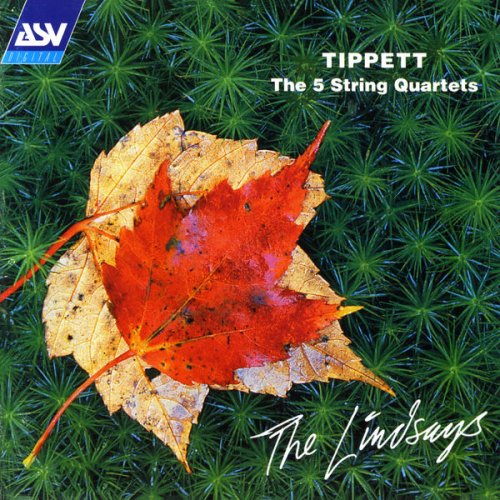
The Lindsays - Michael Tippett: The 5 String Quartets (1996)
BAND/ARTIST: The Lindsays, Lindsay String Quartet, Peter Cropper, Ronald Birks, Roger Bigley, Bernard Gregor-Smith
- Title: Michael Tippett: The 5 String Quartets
- Year Of Release: 1996
- Label: Decca (UMO) / ASV
- Genre: Classical
- Quality: FLAC (tracks)
- Total Time: 2:02:39
- Total Size: 550 MB
- WebSite: Album Preview
Tracklist:
Disc 1
1. String Quartet No. 1: 1. Allegro (06:44)
2. String Quartet No. 1: 2. Lento cantabile (07:40)
3. String Quartet No. 1: 3. Allegro assai (04:59)
4. String Quartet No. 2: 1. Allegro grazioso (06:27)
5. String Quartet No. 2: 2. Andante (05:50)
6. String Quartet No. 2: 3. Presto (02:56)
7. String Quartet No. 2: 4. Allegro appassionato (05:36)
8. String Quartet No. 3: 1. Grave e sostenuto - Allegro moderato (07:58)
9. String Quartet No. 3: 2. Andante (07:13)
10. String Quartet No. 3: 3. Allegro molto e con brio (03:34)
11. String Quartet No. 3: 4. Lento (07:57)
12. String Quartet No. 3: 5. Allegro comodo (04:02)
Disc 2
1. String Quartet No. 4: First movement: Molto legato (02:50)
2. String Quartet No. 4: Second Movement: Fast (06:21)
3. String Quartet No. 4: Third Movement: Moderately slow (05:52)
4. String Quartet No. 4: Fourth Movement: Very fast (08:34)
5. String Quartet No. 5: 1. Medium fast - very fast (11:00)
6. String Quartet No. 5: 2. Slow - medium fast (16:58)
Disc 1
1. String Quartet No. 1: 1. Allegro (06:44)
2. String Quartet No. 1: 2. Lento cantabile (07:40)
3. String Quartet No. 1: 3. Allegro assai (04:59)
4. String Quartet No. 2: 1. Allegro grazioso (06:27)
5. String Quartet No. 2: 2. Andante (05:50)
6. String Quartet No. 2: 3. Presto (02:56)
7. String Quartet No. 2: 4. Allegro appassionato (05:36)
8. String Quartet No. 3: 1. Grave e sostenuto - Allegro moderato (07:58)
9. String Quartet No. 3: 2. Andante (07:13)
10. String Quartet No. 3: 3. Allegro molto e con brio (03:34)
11. String Quartet No. 3: 4. Lento (07:57)
12. String Quartet No. 3: 5. Allegro comodo (04:02)
Disc 2
1. String Quartet No. 4: First movement: Molto legato (02:50)
2. String Quartet No. 4: Second Movement: Fast (06:21)
3. String Quartet No. 4: Third Movement: Moderately slow (05:52)
4. String Quartet No. 4: Fourth Movement: Very fast (08:34)
5. String Quartet No. 5: 1. Medium fast - very fast (11:00)
6. String Quartet No. 5: 2. Slow - medium fast (16:58)
Tippett coached the The Lindsays for these recordings of his first three quartets, and wrote the other two for the quartet. In a note written for their 25th anniversary in 1992 he said that in these recordings they were 'concerned to establish good precedents in matters of style, so that succeeding generations of interpreters start at an advantage'.
In fact one of the most enjoyable things about these readings is that they're so very characteristic of the The Lindsays. A number of the qualities you might call 'characteristic' are uncommonly well suited to Tippett's earlier quartets: big tone, vigour of attack and an infectious enjoyment of his lithe sprung rhythms. These performances are excellent precedents for later interpreters. They establish a style – big-scaled, urgently communicative – that's presumably 'authentic' and yet they challenge listeners as well as other performers to imagine how else they might be done. They also affirm the aching absence of a quartet between the Third and the Fourth (Tippett intended to write one in the late 1940s or early 1950s but got sidetracked by The Midsummer Marriage) and make one wonder what the rejected two movements of the First Quartet might be like. It's wonderful, though, to hear the five as a sequence in such authoritative readings. The recordings sound very well, but have been transferred at an exceptionally high level. — Gramophone Classical Music Guide, 2010
In fact one of the most enjoyable things about these readings is that they're so very characteristic of the The Lindsays. A number of the qualities you might call 'characteristic' are uncommonly well suited to Tippett's earlier quartets: big tone, vigour of attack and an infectious enjoyment of his lithe sprung rhythms. These performances are excellent precedents for later interpreters. They establish a style – big-scaled, urgently communicative – that's presumably 'authentic' and yet they challenge listeners as well as other performers to imagine how else they might be done. They also affirm the aching absence of a quartet between the Third and the Fourth (Tippett intended to write one in the late 1940s or early 1950s but got sidetracked by The Midsummer Marriage) and make one wonder what the rejected two movements of the First Quartet might be like. It's wonderful, though, to hear the five as a sequence in such authoritative readings. The recordings sound very well, but have been transferred at an exceptionally high level. — Gramophone Classical Music Guide, 2010
As a ISRA.CLOUD's PREMIUM member you will have the following benefits:
- Unlimited high speed downloads
- Download directly without waiting time
- Unlimited parallel downloads
- Support for download accelerators
- No advertising
- Resume broken downloads


